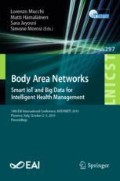Abstract
Falls are common events among human beings and raised a global health problem. Wearable sensors can provide quantitative assessments for fall-based movements. Automatic fall detection systems based on the wearable sensors are becoming popular in recent years. This paper proposes a new fall detection system based on the smart insole. Each smart insole contains pressure a pressure sensor array and can provide abundant pressure information during the daily activities. According to such information, the system can successfully distinguish the fall from other activities of daily livings (ADLs) using deep learning algorithms. To reduce the computational complexity through the classifiers, the raw data for each sensor in the time windows are utilized. Furthermore, the deep visualization approach is applied to provide an intuitive explanation of how the deep learning system works on distinguishing the fall events. Both quantitative and qualitative experiments are demonstrated in this paper to prove the feasibility and effectiveness of the proposed fall detection system.
We thank the Institute for Smart, Secure and Connected Systems (ISSACS) for support.
Access this chapter
Tax calculation will be finalised at checkout
Purchases are for personal use only
References
Vallejo, M., Isaza, C.V., Lopez, J.D.: Artificial neural networks as an alternative to traditional fall detection methods. In: 2013 35th Annual International Conference of the IEEE Engineering in Medicine and Biology Society (EMBC), pp. 1648–1651. IEEE (2013)
Abbate, S., Avvenuti, M., Bonatesta, F., Cola, G., Corsini, P., Vecchio, A.: A smartphone-based fall detection system. Pervasive Mobile Comput. 8(6), 883–899 (2012)
Simonyan, K., Vedaldi, A., Zisserman, A.: Deep inside convolutional networks: visualising image classification models and saliency maps. arXiv preprint arXiv:1312.6034 (2013)
Zeiler, M.D., Fergus, R.: Visualizing and understanding convolutional networks. CoRR, abs/1311.2901v3 (2013)
Khawandi, S., Ballit, A., Daya, B.: Applying machine learning algorithm in fall detection monitoring system. In: 2013 5th International Conference on Computational Intelligence and Communication Networks (CICN), pp. 247–250. IEEE (2013)
Yu, M., Rhuma, A., Naqvi, S.M., et al.: A posture recognition-based fall detection system for monitoring an elderly person in a smart home environment. IEEE Trans. Inf. Technol. Biomed. 16(6), 1274–1286 (2012)
Lara, O.D., Labrador, M.A., et al.: A survey on human activity recognition using wearable sensors. IEEE Commun. Surv. Tutor. 15(3), 1192–1209 (2013)
Chen, D., Cai, Y., Huang, M.C.: Customizable pressure sensor array: design and evaluation. IEEE Sens. J. 18(15), 6337–6344 (2018)
Cumming, R.G., Salkeld, G., Thomas, M., Szonyi, G.: Prospective study of the impact of fear of falling on activities of daily living, SF-36 scores, and nursing home admission. J. Gerontol. Ser. A: Biol. Sci. Med. Sci. 55(5), M299–M305 (2000)
Costs of falls among older adults. https://www.cdc.gov/homeandrecreationalsafety/falls/fallcost.html
WHO global report on falls prevention in older age. https://www.who.int/ageing/projects/falls_prevention_older_age/en/
Delahoz, Y.S., Labrador, M.A.: Survey on fall detection and fall prevention using wearable and external sensors. Sensors 14(10), 19806–19842 (2014)
Lapierre, N., Neubauer, N., Miguel-Cruz, A., Rincon, A.R., Liu, L., Rousseau, J.: The state of knowledge on technologies and their use for fall detection: a scoping review. Int. J. Med. Inform. 111, 58–71 (2018)
Fortino, G., Gravina, R.: Fall-MobileGuard: a smart real-time fall detection system. In: Proceedings of the 10th EAI International Conference on Body Area Networks, pp. 44–50. ICST (Institute for Computer Sciences, Social-Informatics and Telecommunications Engineering) (2015)
Huynh, Q.T., Nguyen, U.D., Irazabal, L.B., Ghassemian, N., Tran, B.Q.: Optimization of an accelerometer and gyroscope-based fall detection algorithm. J. Sens. 2015(1–8), 2015 (2015)
Gharghan, S., et al.: Accurate fall detection and localization for elderly people based on neural network and energy-efficient wireless sensor network. Energies 11(11), 2866 (2018)
Taramasco, C., et al.: A novel monitoring system for fall detection in older people. IEEE Access 6, 43563–43574 (2018)
Bourke, A.K., et al.: Evaluation of waist-mounted tri-axial accelerometer based fall-detection algorithms during scripted and continuous unscripted activities. J. Biomech. 43(15), 3051–3057 (2010)
Kangas, M., Konttila, A., Lindgren, P., Winblad, I., Jämsä, T.: Comparison of low-complexity fall detection algorithms for body attached accelerometers. Gait Posture 28(2), 285–291 (2008)
O’neill, T.W., et al.: Age and sex influences on fall characteristics. Ann. Rheum. Dis. 53(11), 773–775 (1994)
Acknowledgement
The paper was carried out with support from the IoT Collaborative and the Cleveland Foundation and Ohio Bureau of Workers’ Compensation: Ohio Occupational Safety and Health Research Program.
Author information
Authors and Affiliations
Corresponding author
Editor information
Editors and Affiliations
Rights and permissions
Copyright information
© 2019 ICST Institute for Computer Sciences, Social Informatics and Telecommunications Engineering
About this paper
Cite this paper
Qian, X. et al. (2019). The Smart Insole: A Pilot Study of Fall Detection. In: Mucchi, L., Hämäläinen, M., Jayousi, S., Morosi, S. (eds) Body Area Networks: Smart IoT and Big Data for Intelligent Health Management. BODYNETS 2019. Lecture Notes of the Institute for Computer Sciences, Social Informatics and Telecommunications Engineering, vol 297. Springer, Cham. https://doi.org/10.1007/978-3-030-34833-5_4
Download citation
DOI: https://doi.org/10.1007/978-3-030-34833-5_4
Published:
Publisher Name: Springer, Cham
Print ISBN: 978-3-030-34832-8
Online ISBN: 978-3-030-34833-5
eBook Packages: Computer ScienceComputer Science (R0)

